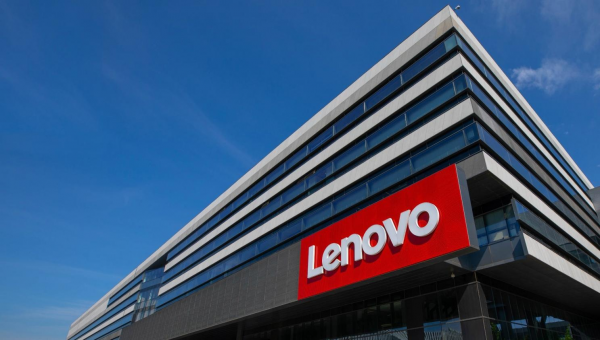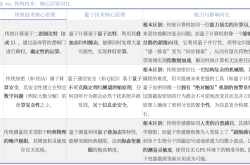Lenovo's 'Oracle Moment': An Aging Giant's AI Pivot and Valuation Reassessment!
![]() 11/28 2025
11/28 2025
![]() 359
359

Author: Lin Yi
Editor: Key Focus
The generative AI wave, led by ChatGPT, is fundamentally reshaping the global tech industry. It represents not just a software innovation but a complete overhaul of the hardware, computing power, algorithms, and service ecosystems across the entire industry chain.
The capital market's valuation framework is rapidly evolving. NVIDIA has ascended to the top of global market cap with its GPUs, while Microsoft, Google, and other giants have secured their positions through 'cloud + AI' strategies. The market is no longer solely fixated on traditional profit metrics but is aggressively rewarding companies that control the essential 'water, electricity, and coal' resources of the AI era.
The latest Oracle story epitomizes this phenomenon: once seen as a stagnant value trap, the database giant bet big on cloud and AI. As the wave hit, its cloud services emerged as a dark horse, perfectly aligning with GPU computing demands, driving up both valuation and stock price in a 'Davis Double Play.'
This is a classic case of an 'aging giant' betting on a 'new track' to regain vitality. As the market searches for the next NVIDIA, it should also look for the next Oracle. In terms of business performance and transformation logic, Lenovo Group is currently experiencing its own 'Oracle Moment.'
Structural Transformation: The Misunderstood Hardware Maker
Much like how Oracle was once viewed as a 'traditional database company,' the capital market still tends to assess Lenovo Group through an outdated lens: the world's largest PC manufacturer. This hardware label corresponds to a highly cyclical, low-margin business model reliant on shipment volumes. In the eyes of the capital market, it deserves only a 'manufacturer' valuation logic—a low anchor based on earnings (PE), typically in the single digits.
This stereotype is largely tied to Lenovo's long-standing and absolute dominance in the PC market. According to IDC's latest data, Lenovo Group held a 25.6% market share in the PC sector in the third quarter of 2025, securing the global top spot while widening its lead over HP and Dell. However, this success has overshadowed a profound structural transformation within the company, becoming the biggest obstacle for investors to recognize its new value.
In reality, Lenovo's foundation has quietly shifted. A close review of its financial reports over the past three years reveals a clear trajectory: AI is becoming the core driver for Lenovo to navigate through cycles. The primary growth logic for its revenue and profits is no longer solely tied to hardware cycles but has transitioned to the compound growth of AI infrastructure and service ecosystems. Lenovo's transformation and business reshaping share similarities with Oracle's journey.
The latest financial results underscore this transformation. In the second quarter of FY 2025/26 (ending September 30, 2025), Lenovo Group's total revenue grew 15% year-on-year to RMB 146.4 billion, a new quarterly record that surpassed market expectations. Adjusted net profit rose 25% year-on-year to RMB 3.66 billion.
Breaking down the business segments, IDG (Intelligent Devices Group) maintained its leading position with revenue of RMB 108.1 billion, up 12% year-on-year, and its PC market share exceeded 25% for the first time.
ISG (Infrastructure Solutions Group) delivered a standout performance, with revenue surging 24% year-on-year to RMB 29.3 billion. AI server revenue achieved high double-digit growth, while revenue from Neptune liquid-cooled servers soared 154% year-on-year. Meanwhile, SSG (Services & Solutions Group) achieved an operating margin exceeding 22%, marking its 18th consecutive quarter of double-digit growth and becoming the profit anchor for the group.
As of the latest fiscal quarter, AI-related business revenue accounted for 30% of Lenovo Group's total, up 13 percentage points year-on-year. This structural shift signifies that AI has become a substantial contributor to performance.
With a significant reduction in cyclical fluctuations in its results, Lenovo Group's valuation anchor should also shift—from the 'manufacturer PE' logic tied to hardware cycles to the 'tech services PS (price-to-sales)' logic driven by AI. The capital market's perception of Lenovo Group lags behind the actual evolution of its business.
New Growth Engine: Dual Drive of SSG and ISG
A review of how Lenovo Group navigated through industry cycles over the past three years reveals the clearest picture of its transition from old to new growth drivers.
FY 2022/23 was a 'disaster year' for the PC industry. The post-pandemic boom faded, and demand plummeted. Lenovo's IDG revenue plunged 21%. If Lenovo were merely a PC manufacturer, this would have been a double blow to revenue and profits.
However, the other side of the financial report tells a different story: in the same year that the PC business hit rock bottom, Lenovo's new growth engines kicked into full gear. SSG revenue grew 22% against the trend to USD 6.7 billion, with profits up 16%. ISG revenue surged 37% to USD 9.8 billion, achieving full-year profitability for the first time.
These two counter-cyclical engines enabled Lenovo to have non-PC businesses account for nearly 40% of its revenue in that 'disaster year' and stabilized the group's gross margin. This storm proved to the capital market for the first time that Lenovo's foundation was no longer just PCs.
SSG is the profit anchor for Lenovo's transformation and the key to understanding its new value. It does not offer one-time hardware sales but subscription-based services like DaaS (Device-as-a-Service), along with IT lifecycle management, consulting, and solutions for enterprises.
The unique financial characteristics of this business are high margins, high stability, and high stickiness.
In Q2 2025/26, SSG's operating margin exceeded 22%, nearly triple that of the PC business. More importantly, SSG's growth has shown strong resilience. Even during the industry's lowest point in FY 2023/24, when group revenue declined 8%, SSG still achieved 12% revenue growth and 11% profit growth. By FY 2024/25, the division had set new records for revenue and profits for the fourth consecutive year.
Notably, SSG's internal business is also shifting toward higher-value areas. Financial reports show that revenue from high-margin managed services and project & solutions services grew over 20% in FY 2024/25, accounting for 58% of SSG's total revenue. By Q2 2025/26, AI service revenue had achieved triple-digit explosive growth.
This means SSG's profit quality is continuously improving, transitioning from hardware-dependent add-ons to independently growing, solution-based core offerings. SSG's presence is fundamentally altering Lenovo's profit structure. The valuation logic for this business clearly falls under the tech services category.
If SSG is the profit cornerstone for Lenovo Group, then ISG is the engine driving its second growth curve by seizing AI-era opportunities. ISG's portfolio includes AI servers, storage, and edge computing—essential computing infrastructure for the AI large model era.
ISG's growth trajectory vividly demonstrates Lenovo's strategic pivot toward AI. In FY 2023/24, ISG's annual revenue declined 9% due to global IT budgets shifting toward AI, causing a pause in traditional server procurement as the market rushed to adopt AI servers.
Lenovo quickly seized this signal. By Q4 2023/24, ISG had reversed its downturn, with quarterly revenue returning to a 15% growth trajectory.
The following FY 2024/25 became a breakthrough year for ISG. Annual revenue surged 63% year-on-year to a record USD 14.5 billion, achieving profitability in the second half of the year. The core growth driver was AI. Q2 2025/26 financial results further confirmed this trend: ISG revenue grew 24% year-on-year, maintaining multi-quarter growth, with AI server revenue sustaining high double-digit growth.
ISG's growth is comprehensive, driven by both cloud service providers and enterprises/SMEs. Lenovo's unique advantage in ISG lies in its 'ODM+' model and advanced liquid cooling technology. With AI chip power consumption soaring, liquid cooling has become a core competitiveness (competitive edge) for data centers.
ISG's robust growth indicates that Lenovo has successfully entered the golden track of AI infrastructure, becoming one of the core suppliers in the global AI computing race. This high-speed growth aligned with trends should be valued based on 'growth potential' rather than 'cyclicality.'
Hybrid AI: The Formation of a Strategic Closed Loop
The success of SSG and ISG is not merely isolated departmental performance but a concentrated expression of Lenovo Group's 'Hybrid AI' strategy.
What is 'Hybrid AI'? It is essentially a 'cloud + edge + endpoint' collaborative computing architecture, representing Lenovo's core strategy in the AI era. AI deployment has three typical scenarios: pure cloud AI suffers from high costs and privacy risks; pure endpoint AI has limited capabilities. Lenovo's heavy investment in Hybrid AI balances flexible computing power allocation, privacy security, and cost efficiency by intelligently distributing workloads across cloud, edge, and endpoint devices.
Lenovo firmly believes that the future of AI must be hybrid. For AI to achieve universal accessibility, it cannot rely on a few large model providers offering uniform services but must deliver personalized, enterprise-specific intelligent agents whose data foundations must originate from individuals or enterprises themselves.
To achieve this, enterprises must control both 'endpoints' and 'the cloud.' Lenovo Group is one of the few global companies with massive scale on both the B (business) and C (consumer) ends. Its years of global operational experience enable it to manage the complexities of parallel B/C operations.
This unique market position allows Lenovo's 'Hybrid AI' strategic puzzle to fit together seamlessly. Its three major business groups each play a distinct role:
IDG (Intelligent Devices Group) serves as the AI endpoint gateway. As the absolute leader in the global PC market, Lenovo controls the largest gateway for AI to reach users.
ISG (Infrastructure Solutions Group) provides the computing foundation for AI. It supplies public cloud and localized AI computing power to CSPs and enterprises, precisely addressing core concerns like data privacy.
SSG (Services & Solutions Group) acts as the AI integration hub. It packages 'endpoints' and 'the cloud' into AI-empowered solutions, transforming one-time hardware sales into long-term, high-value service contracts.
Together, these three business groups form a commercial closed loop spanning hardware to software, endpoints to cloud, and one-time sales to subscription services. The completion of this strategic puzzle signifies a fundamental transformation in Lenovo's business model.
AI Gateway: The Reinvention of the PC Business
Even Lenovo Group's most traditional PC business (IDG) is being reshaped by AI in this comprehensive transformation toward AI.
The emergence of AI PCs is rapidly dismantling the narrative that 'PCs are dead.' Industry consensus recognizes it as the most significant structural change in the PC industry since the internet era, poised to initiate a new supercycle of device replacements.
The global AI industry structure can be roughly divided into four layers: computing power (NVIDIA), platform (Microsoft Azure, Amazon AWS), algorithm (OpenAI), and endpoint/gateway. Lenovo Group, alongside Apple and Samsung, occupies the gateway layer. 'Controlling the gateway controls the ecosystem' is a proven axiom from the PC and mobile internet eras. In the AI era, the gateway's value remains undiminished.
This is evident from the actions of tech giants: Google is rapidly iterating its Pixel phones and glasses, Meta is betting heavily on Ray-Ban smart glasses, and ByteDance is exploring hardware boundaries through Pico and earphones. These software and algorithm giants are scrambling to acquire hardware capabilities because they realize that without endpoint devices, AI algorithms remain mere code on servers, unable to reach users. NVIDIA has partnered with Intel to capture the AI PC market. Even OpenAI, unsatisfied with model-layer and software layout (strategic positioning), is seeking breakthroughs in hardware.
As the absolute leader in the global PC market, Lenovo Group is the biggest beneficiary of this replacement cycle. Data is already showing the impact: IDG maintained strong performance in Q2 2025/26, with growth driven primarily by increased AI PC penetration. In this fiscal quarter, AI PCs accounted for 30% of Lenovo's China notebook shipments and 31.1% of the global Windows AI PC market. Revenue from AI endpoint devices surged to 36% of IDG's total.
The significance of AI PCs extends beyond driving sales—it enhances value. AI PCs command significantly higher average selling prices and profit margins than traditional PCs, structurally improving IDG's profitability. AI has not rendered the PC business obsolete but has instead returned it to the tech spotlight. IDG has never been a historical burden for Lenovo Group but an indispensable gateway in its 'Hybrid AI' strategy.
Supporting Lenovo Group's 'Hybrid AI' strategy implementation are two often-overlooked moats: relentless R&D investment and global operational capabilities.
First is its unwavering R&D commitment. A review of over the years (annual) financial reports reveals a clear investment trajectory: in FY 2022/23, during the industry downturn, R&D spending grew 6%. In FY 2023/24, R&D expenditure reached 3.6% of revenue, a record high. In FY 2024/25, R&D spending increased another 13% to USD 2.3 billion. By H1 FY 2025/26, R&D investment maintained an 8% year-on-year growth. Sustaining high R&D intensity during industry downturns underpins Lenovo's confidence in its AI pivot.
Second is its unique 'global resources + local delivery' operational model. Amid rising deglobalization and trade friction, supply chain resilience and security hold value comparable to technology itself. Lenovo's most overlooked strength lies in its 30+ manufacturing bases worldwide, enabling flexible hedging against geopolitical risks, tariff barriers, and supply chain disruptions. Its profound expertise in simultaneously managing complex B2B and B2C operations across 180 markets is a capability few competitors can replicate quickly.
Valuation Reassessment: PS More Rational Than PE
Both Lenovo Group's financial data and strategic layout (positioning) point to one conclusion: its foundation has changed. However, the capital market's perception lags significantly. This lag is most evident in the misjudgment of Lenovo's valuation logic.
From the old perspective, the market views Lenovo as a hardware assembler: revenue heavily dependent on PC sales, exhibiting strong cyclicality and low profit margins. The capital market assigns it an extremely low PE (price-to-earnings ratio), with stock prices volatile in response to PC shipment data. The flaw in the PE logic is that it obscures Lenovo's ongoing qualitative transformation, ignores changes in revenue quality, and penalizes growth-phase investments.
Traditional manufacturing PE valuation overlooks the SaaS-like characteristics introduced by SSG. Within SSG, the rising share of subscription-based revenue from DaaS, managed services, and other offerings—characterized by high margins, high stickiness, and recurring income—is precisely why capital markets typically value cloud computing and software companies using PS (price-to-sales) metrics.
Under the new valuation anchor, the correct logic for investors should be: revenue is jointly driven by three major engines, namely AI infrastructure (ISG), AI services (SSG), and AI terminals (IDG).
The traditional PE valuation for manufacturing overlooks the SaaS characteristics brought by SSG. In SSG business, the proportion of subscription-based revenues such as DaaS and operational maintenance services continues to rise. These businesses are characterized by high gross margins, high stickiness, and recurring revenues, which is precisely the core rationale for capital markets to typically use PS for valuing cloud computing and software companies.
More critically, these three engines do not exist in isolation but form a rigorous logical closed loop: the massive device shipments of IDG create a natural entry point for AI services; the increasingly complex hybrid AI infrastructure of ISG creates rigid demand for operational maintenance and consulting services from enterprises. The scaled growth of IDG and ISG has driven the high-margin SSG business. The triple-digit growth in AI service revenue within SSG this fiscal quarter is the best evidence of this flywheel effect:
This new business portfolio exhibits the characteristics of technology services that are 'high-growth, high-profit, and de-cyclical': ISG is deeply tied to AI computing power, SSG provides stable cash flows with high profits, and non-PC businesses and subscription revenues effectively smooth out hardware cycle fluctuations.
Another obvious valuation mismatch is that the market is willing to assign Dell a PE of approximately 17 times but only assigns Lenovo Group, which has twice the growth rate in AI infrastructure and holds high-profit services and leads in AI PCs, a PE of about 10 times. The market has not fully recognized the flywheel effect within Lenovo Group.
Therefore, the most reasonable valuation approach for Lenovo Group should be the Sum-of-the-Parts (SOTP) method: assign a reasonable PE to IDG as a mature hardware leader; assign a growth-oriented valuation to ISG by referencing AI server peers; and for the high-growth, high-margin SSG, reference the logic of IT service providers or tech transformation giants like Oracle and attempt to align with the PS valuation system.
Conclusion
AI has not only become the driving force for innovation at Lenovo Group but has also emerged as a substantial contributor to its performance.
The massive device shipments of IDG create a natural entry point for AI services; the increasingly complex hybrid AI infrastructure of ISG creates rigid demand; together, they provide a continuous stream of 'fuel' for the high-margin SSG.
Today's Lenovo Group is no longer the manufacturer that relied solely on PC shipments to 'weather the storm'; it has successfully transformed into an infrastructure and service provider for the AI era. With the accelerated penetration of AI, the AI business will evolve from a supporting role to the core growth driver in its business portfolio, propelling the overall business structure toward higher value.
If investors continue to view Lenovo Group through the PE logic of a PC manufacturer, they will only miss out on this core player that holds significant weight in the AI wave. The market will eventually correct this stereotype, and Lenovo Group's valuation logic will ultimately align with that of AI tech growth stocks.







